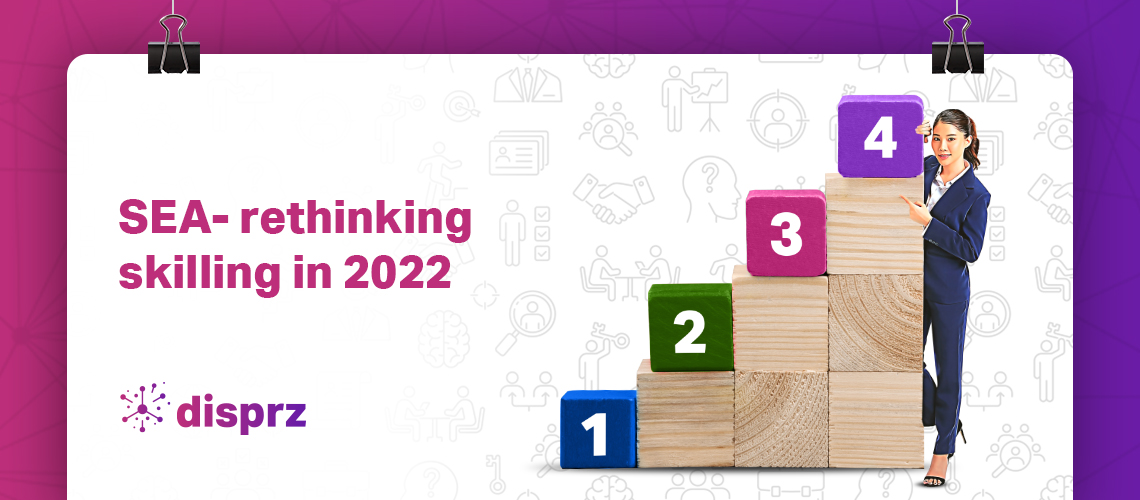Whether it’s Singapore, Thailand, Indonesia, or Malaysia, employee skilling has been the core focus of Southeast Asian organizations. Companies in these countries understand that to reach the business revenue goals, it is important to fill the skill gaps of the knowledge and frontline workforce. The employees’ performance can help a company climb the stairs of success.
“If you look at the history of Singapore, we have been looking at workforce reskilling since the day the nation was created,” quoted Gog Soon Joo, the Chief Skills Officer at SkillsFuture Singapore.
As the dust settles from the disruption caused by the pandemic, attention shifts towards a digital economy. With digital acceleration in Southeast Asia, the skilling game needs a new approach in 2022 to fuel Southeast Asia’s growth engine. Building new learning and skilling strategies is pivotal to expanding competencies for making the employees future-ready and resilient to respond to any challenges that come their way.
Skilling lessons to learn from 2021
The Covid-Crisis and 2021’s Great Resignation had an indelible impact on L&D functions last year. There was an unimaginable level of changes implemented to survive and thrive. However, some critical areas remained untouched last year, leading to poor employee performance that even impacted the 2021 goals of many of Southeast Asia’s businesses. Before we delve into shaping skilling in 2022, let’s take a step back and mull over the lessons that 2021 taught us.
1) What didn’t work in 2021 – Failure to quickly pivot in learning and development resulted in missed opportunities last year.
Lesson – Adopt an agile learning approach to quickly adapt and respond to new challenges.
2) What didn’t work in 2021 – Lack of innovation in L&D led to a low engagement rate.
Lesson – Experiment and explore various technologies to make learning more interactive and interesting.
3) What didn’t work in 2021 – Failure to integrate learning needs with learning programs resulted in a low completion rate.
Lesson – Analyse the skill gap, identify skills needed for each role, and personalize learning to bridge each employee’s skill gap.
4) What didn’t work in 2021 – Failure to prepare employees for new responsibilities that evolved post-pandemic.
Lesson – Focus on developing new skills that can be applied across different functions.
Critical 4 steps Southeast Asian companies must take in 2022 to shape skilling
A renewed skilling dynamics is crucial to help the workforce in SEA excel and deliver optimum performance in 2022. While transforming strategies in 2022, make sure you link employee learning and skilling to business-led outcomes. Employee performance plays a significant role in achieving company goals. So it is crucial that learning and the organization’s goals/priorities are aligned. A progressive ambition and new skills are pivotal to building competencies for a future-forward company.
Below are the steps your company must take to shape skilling in 2022.
1. Move towards role-based skilling and personalized learning
Businesses across Southeast Asia are moving towards personalization to make their learning and development more effective for driving business impact.
One of Myanmar’s largest commercial banks created learning journeys that were hyper-personalized to each learner across different branches. This helped them increase their average learning hour per employee. Click here to read the full case study.
The latest advancement in AI will help take personalized learning to the next level in 2022. With the help of cutting-edge technology like Disprz, you can determine skills for each role and accordingly create personalized journeys to develop those skills. Role-based skilling can help identify the right skills in real time to make employees future-ready. Moreover, AI-based recommendations based on past learning behavior will help increase engagement and augment learning experiences.
77% of learning and development professionals believe that personalized learning is critical to employee engagement
2. Switch from in-person training to technology-based training
In-person training is without a doubt an effective way of disseminating knowledge or information. However, it fails to support modern concepts like learning-in-the-flow-of-work and hybrid working. With digital acceleration in Southeast Asia, companies need to look for smart solutions to offer timely learning and development.
Employee skilling programs are conducted to enhance skills to meet business needs. Combining the skilling strategies with the right learning technology can help create the desired business impact. Modern learning solutions can smoothen and transform employee development programs. You can easily create learning journeys and assign courses to the employees. Modern learning solutions even help in tracking the learning progress and measuring its impact on employee performance.
3. Explore cross-skilling to empower people to take up new roles
Cross-skilling is a trend that has captured a lot of attention, especially post-COVID. Companies from Singapore, Malaysia, Thailand, Vietnam, Indonesia, and other parts of Southeast Asia are trying to make the most of their existing talents rather than hiring new employees.
“One of the learning trends that I have noticed in Southeast Asia is Cross-Skilling. Most companies are focusing a lot on how the talent management requirements can be fulfilled by not looking externally but looking internally by crossing skilling employees.” – said Vineet Koka, SEA Director, disprz in the webcast – Skilling Outlook 2022: Priorities and the Way Forward
Cross-skilling goes beyond basic or core skills. It focuses on building the proficiency level of the employees to carry out roles apart from their existing responsibilities efficiently. Cross-skilling benefits both the employee and the company; for instance, a social media specialist is interested in SEO. So you can give him the required training to build SEO skills for assisting the SEO manager. This will help in saving employee hiring and onboarding costs.
Building skills beyond the existing role not only helps in saving hiring costs but also in offering a consistent service to the client. For instance, a team member had to go on emergency leave; in that case, someone else from the team who has been cross-skilled and knows about the project can handle his client to offer optimum experience. Cross-skilling helps empower employees and get the right support during difficult times.
4. Make learning interesting and engaging with gamification
Gamified learning is 2022’s most trending strategy for corporate learning and development. Companies in Southeast Asia are adding the gaming element to learning to boost engagement.
L&D professionals from southeastern companies are making skilling sessions interactive and interesting by using gameinar features like text wall, roulette wheel, polls, breakout room, etc.
Moreover, features like leaderboards and badges help motivate employees to learn more.
“Gamification of learning is a key contributor to the learning process’s success. People feel more engaged. The more they learn, the more benefits they will receive.” – said Swasono Satyo, CHRO, Sinar mining in the webcast – Skilling Outlook 2022: Priorities and the Way Forward
Conclusion
Revamping the skills of each employee can help improve productivity and efficiency to achieve better business outcomes in 2022. It is time to rethink your learning strategies and technologies. More advanced technologies are being introduced in the learning space that can help transform employee skilling and development. Disprz is one such AI-powered learning platform. It is a complete skilling suite that can in onboarding, upskilling, and taking the employee to the next level. See a preview to experience Disprz in action.









